|
This
feature appears in Auto Italia - Issue 108 -
July/August
2005 |
|
|
Well, this is
unexpected. I’ve just been flung around the Nürburgring
Nordschleife at great speed in a new Alfa 159, dodging
between that peculiar breed of German track-day special that
only the ‘Ring spawns and wondering if I’ll ever remember
where any of it goes, and now it’s my turn. And the test
driver has just walked away, leaving me and a rather
valuable 159 containing a certain amount of test gear.
Trusting, or what?
It’s one thing
to be let loose, alone, on such a sinuous, hazardous circuit
in an important new car on whose test programme the finer
honing of production versions may depend. But it’s quite
another to tick those foregoing boxes and to mix it with
nitrous-fuelled BMW M3s and Audi A3s with unfeasibly wide
wheels and all varieties of well-thrashed, but not always
well-driven, Porsche 911. Still, here goes. And now it’s
raining.
This 159 is the
top of the new range, a 3.2-litre V6 with standard-fit
four-wheel drive. Its torque split is nominally 43% front,
57% rear, but up to 80% can head rearwards via the Torsen-C
centre differential should conditions and cornering forces
demand it. There was a lot of rearward torque diversion on
the test driver’s hot lap. I was sitting in the back – it’s
notably roomier than the 156’s rear cabin, by the way – and
I could feel how far the Alfa was angled to the direction of
travel as the cornering speed climbed.
But I’m still
mindful of the 156 GTA, and its necessarily compromised
grip/steering/ride combination, as I unleash the 260bhp on
offer from the 159 Q4’s 260bhp, GM-based but Alfa-tailored
engine. That’s 10bhp more than the GTA, but there are no
histrionics at all. Every last twitch of those horses’
muscles is transferred faithfully to the ‘Ring’s
graffiti-covered track surface; no pull, no tug, no
scrabbling. It’s a perfect flow, channelled just where it
needs to be.
The engine is
pulling heartily, way up in the higher registers even though
it’s strong on low-speed pull. That said, the 237lb ft
torque peak is numerically lower than the bhp figure, always
an indicator of an essentially revvy engine and a simple
comparator lost when people divert into Newton-metres and
kilowatts. Glad I’ve got that off my chest. The sound is
authentic V6 Alfa, helped by the unique, direct-injection
Alfa heads with their variable inlet and exhaust timing. All
seems to be true to the brand, no expense has been spared.
This time, Alfa Romeo really is going head-to-head with the
Germans, and we’re even proving it on German soil. And then,
three-quarters of the way round between the Karussell and
the smaller version of the same half-banked corner, the
rev-limit appears suddenly to have dropped. I change up and
there’s nothing. Never overlook the obvious: the Alfa has
run out of petrol. I dive for the bank to keep out of the
way of wayward 911s, and await rescue. Very embarrassing.
But never mind; I’ve learnt a lot about the 159, and such a
version would make a fine base for a WTCC car if only the
rules allowed this many litres and that many driven wheels.
Right now, though, it’s back to Alfa’s Nürburgring garage –
159 dynamics guru Carlo Fugazza and his team have been here
for the past two years – and out on the road in some
different 159s.
It’s significant
that Alfa has developed the 159 at the ‘Ring. The track
itself is a kind of ultimate test, and a quick lap time
relative to rivals is a point of honour, but equally
significant are the public roads nearby which have dips,
lumps, bumps and broken surfaces much like those in the UK.
It’s a sad indictment of our underfunded, under-maintained
road network that carmakers now consider the UK a special
case and have to make sure suspension systems can cope here,
and it’s also true that the 156 was a car which didn’t cope
very well. I went on an early 156 drive in Italy, before the
main launch, and all seemed fine. We now know that British
roads changed all that.
So the 159 has a
much stiffer structure, stiffer even than that of the new
BMW 3-series, and its suspension has both more anti-dive and
more travel. There are no carry-over parts at all, and even
the platform is all-new – the so-called Premium platform
that was to have been a joint venture with estranged partner
General Motors but which is now unique to the Alfa-Maserati
axis (159, Brera and probably the Kubang SUV). The rear
suspension is what people lazily refer to as a multi-link
arrangement (geometrically a kind of double wishbone with an
extra toe-control link), while the front bears the same
double-wishbone tag as before but is quite different in
design. The upper wishbones, for example, are no longer
steeply angled back but have conventional pivots parallel
with the Alfa’s longitudinal axis.
I’m back in the
garage and trying to decide if I like the way the 159 looks.
It has presence, definitely; it’s bigger than the 156 (the
wheelbase has grown from 2595mm to 2700), and it looks
sturdier, sharper, tougher if less achingly beautiful than
the 156 as first perceived.
|
 |
|
|
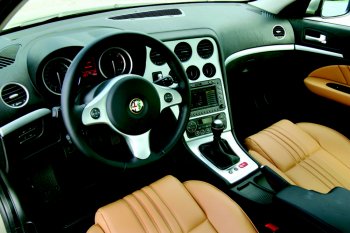 |
|
|
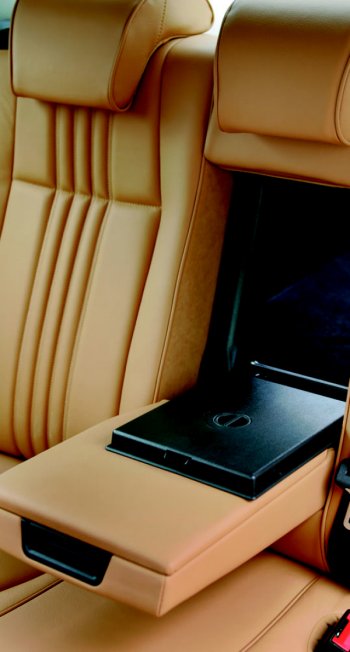 |
|
|
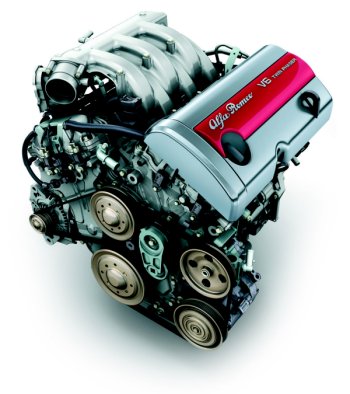 |
|
|
|
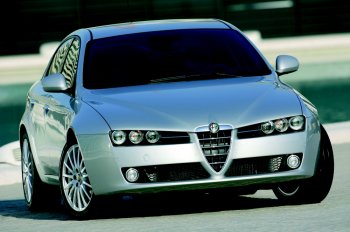 |
|
|
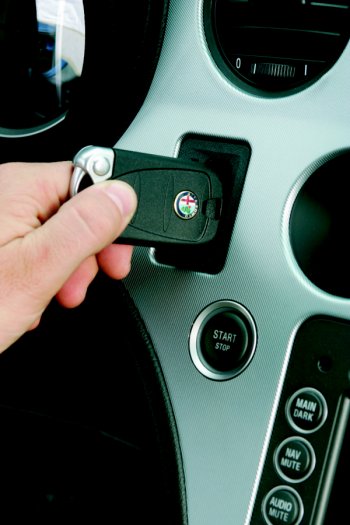 |
|
|
 |
|
|
|
It looks, in fact, more German: “The 159 should fit into a
population of Volkswagens and Mercedes-Benzes,” Alfa CEO
Karl-Heinz Kalbfell had declared earlier in the day, “and it
should have that seriousness.”
But equally he acknowledges that people like the idea of an
Alfa precisely because it isn’t German, because it has a
kind of flair and vivacity and a Latin appeal to the sensual
side of our nature. If Kalbfell, the ex-BMW, ex-Rolls-Royce
German famously in touch with the Italian way of thinking
(but able to bring German rigour to the thought) was to
decide that an Alfa should simply be a BMW copy, then he
might as well give up. Thankfully he knows that would be
pointless.
He also knows that the UK dealer network is in need of a
major attitude transplant, to make customers feel valued and
want to buy another Alfa. Moves are urgently afoot to
achieve this – he wouldn’t reveal what they are, exactly –
and the job should be done in time for the 159’s UK arrival.
Otherwise it would be doomed. The dealers had the 156 (one
of the more significant in a long line of ‘cars to save
Alfa’) and blew it, and it’s not going to be allowed to
happen again.
Whatever,
there’s no doubt at all that the 159 looks a convincing
Alfa. Inside, too, there’s a 156-derived theme although
chunkier and more tactile. Some of these early cars, though,
have a light-coloured dashboard top as often favoured in the
US, a market the 159 will one day enter. Alfas, to my
knowledge, have never had this before and they shouldn’t
now. It looks cheap and the reflections in sunlight are
terrible. Don’t worry, though; conventional black is normal
fare, with black elsewhere or light colours to choice. An
interior all-black except for dark red leather seats looks
especially good.
Other interior
niceties include a starter button, keyless entry and
particularly comfortable front seats with an excellent
driving position. Not so clever is the handbrake, to the
right side of the centre tunnel which means the driver, in
these left-hand drive cars, is forever stroking the front
passenger’s leg. In UK cars the driver will not be so
touchy-feely but the angle of attack on the handbrake will
be awkward.
And so to the
roads, initially in a 2.2-litre JTS whose 185bhp engine,
like the 160bhp 1.9, is again a GM-derived but Alfa-specific
unit with variable inlet and exhaust-cam timing. I’m pleased
to report that it sounds almost exactly like a 2.0 Twin
Spark, with a similar edge to the induction and exhaust
note, but it pulls rather better from low speeds. It also
copes better than its predecessor with a road’s lumps and
dips, with less of the engine shake (a trace remains) and a
taut but absorbent ride. Even Kalbfell himself remarked on
the 159’s comfort on this test route.
The steering is
very quick – like a 156’s – and a little too light, but the
response is more progressive and the whole car feels calmer
and more composed. It’s still highly agile, though, pointing
keenly into corners and letting you alter the line with the
throttle once in them. No need for a sport suspension option
here, and none is offered.
I then tried the
tuneful 2.4 JTD, heavier in the nose, calmer in the ride. It
needs bigger steering movements to counteract the greater
understeer – four-wheel drive is optional – but the
weighting is more credible and the engine’s 200bhp and 295lb
ft of torque give terrific overtaking thrust. The six-speed
gearbox (standard in all 159s, including the petrol and
diesel 1.9s I didn’t sample) makes sure there’s always a
gear to make the most of it.
Finally, it was
time to meet the V6 Q4 again in real-road circumstances.
Six-pot 156s were always the compromised handlers, heavier
and clumsier and lacking the four-cylinder cars’ lightness
of touch. Not so the 159 Q4, thanks of course to the
four-wheel drive. It feels poised and planted on the road,
fluid through the corners, accurately responsive to all
commands. It’s smooth, sonically delicious without being
loud, and it rides excellently. It’s the pick of the range
without a doubt, which isn’t always true of a range’s
grandest model.
Meet, in fact,
the best Alfa Romeo saloon there has ever been. They’ve
cracked it, no more excuses. This time BMW should be
seriously worried.
Technical
Specifications:
Engine: 3195cc
V6-cylinder 24v dohc, variable valve timing, direct
injection; Power: 260bhp @ 6200rpm; Torque: 237lb ft @
4500rpm; Transmission: Six-speed manual, four-wheel drive;
Brakes: 330mm ventilated discs (front) 229mm ventilated
discs (rear), ABS and EBD; Suspension: Double wishbones,
coil springs, anti-roll bar (front) Transverse links with
toe control, coil springs, anti-roll bar (rear); Tyres:
225/50 R17; Dimensions: 4660mm (L), 1828mm (W), 1417mm (H),
2700mm (wheelbase); Kerb weight: 1740kg; Fuel consumption:
24.6mpg (combined); Top speed: 149mph; 0-62mph: 7.0sec;
Price: TBA; Available: December 2005
Test by John Simister /
Photos enhanced by Carrstudio
|
|
This feature appears in Auto Italia, Issue 108,
July-August 2005. Highlights of this month's
issue of the world's leading Italian car
magazine, which is now on sale, includes a road
test of the new the Fiat Stilo Schumacher GP,
riding on the streets of Rome with the
Lamborghini Gallardo police car plus an Italian road-trip with the Maserati GranSport,
the Villa d'Este Conconso d'Eleganza,
a
Fiat 130 sedan, Alfa Romeo 155 buyers guide and
a look at Carrozzerria Boneschi, a less well
known coachbuilder.
Call
+44 (0) 1858 438817 for back issues and subscriptions. |
|
|
website:
www.auto-italia.co.uk |
|
 |
|
|
![]()
![]()